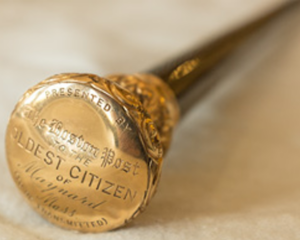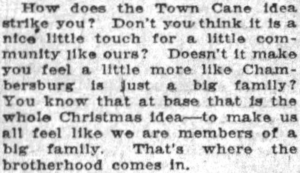The concept of passing a Town Cane to the oldest living male resident began in Boston in 1909, mainly to improve newspaper sales. The Public Opinion newspaper copied the idea twenty years later when Chambersburg implemented the passing of its Town Cane in 1929. Waynesboro followed in 1934. However, people began inquiring into the whereabouts of Chambersburg’s Cane in 1956 and again in 2023. Although each recipient was well documented in over fifty newspaper articles, neither Chambersburg nor Waynesboro’s Town Cane has been located.
The Boston Post Town Cane

In 1891 Edwin Atkins Grozier purchased the Boston Post newspaper which was near bankruptcy. As its publisher and editor, he needed a plan to make his failing newspaper profitable. After bidding on an unclaimed shipment of walking canes, he devised a plan to increase the newspaper’s circulation. On 2 August 1909, Grozier sent letters and canes to approximately seven hundred selectmen (local government officials) in Massachusetts, Maine, New Hampshire, and Rhode Island “with the request that it be presented with the compliments of the Boston Post to the oldest male citizen of the town, to be used by him as long as he lives.”
The canes were manufactured by J. F. Fradley and Company of New York in a year-long process. They were made from seven-foot lengths of Gaboon ebony from the African Congo. The canes were topped with a two-inch 14-carat gold head “engraved with the inscription, ‘Presented by the Boston Post to the oldest citizen of [town, state] (to be transmitted).’”[1]
Although the “rules” seemed clear, questions arose as to who should receive the Cane. The Post’s staff were often asked to settle disputes regarding proof of age, residence, and voting status. The definition of “citizen” was also questioned:
The most common Question has been as to whether both sexes were eligible for the cane. The intention of the Post from the outset has been that the cane should be presented to the oldest male. The word “citizen” has been intended by the Post to mean the oldest registered male voter.[2]
When the Equal Suffrage Amendment was ratified in 1920, the presentation of the Cane was eventually opened to women—in some places.
But not everyone was enthusiastic about receiving a symbol of a marketing scheme or their advancing age. It became harder to find people willing to take the Cane. “Others suspected a scam. A few were scared off by rumors of a curse, and to doom those who dared take the cane home. ‘People now think of it as a reminder of their age and limited time left’.”[3] And canes were sometimes presented to the wrong person. Like the end of the passing of the Town Cane, the Boston Post folded in 1956. Over the years, many Canes were lost, stolen, removed from the town, or just not returned. To date only approximately five hundred original Town Canes have been located.
Pennsylvania’s First Town Cane

Weatherly in Carbon County, Pennsylvania, claims starting their Town Cane tradition earlier than 1909, but this has not been proven.[4] Like the Post, this new tradition was used by the Weatherly Herald newspaper to improve its circulation.[5] J. F. Kressley, Weatherly’s former chief burgess (town mayor), supposedly established the tradition in 1907. “It was the duty of the chief burgess publicly to present it to the oldest man remaining a resident of the borough.” By 1923 Weatherly boasted five recipients with the following inscription on their Town Cane: “Our Tribute to the Oldest Gentleman Resident of Weatherly, and His Successors. September 1907.”[6] On 19 December 1928, Weatherly’s announcement of its seventh Town Cane recipient was printed in Chambersburg’s Public Opinion.[7] Two days later, the newspaper asked its readers, “How does the Town Cane idea strike you?”[8]
(To be continued in Part 2: Chambersburg’s Town Cane)
[1] The Boston Post Cane Information Center (https://bostonpostcane.org).
[2] Barbara Staples, “Launching of the Boston Post Cane,” The Bay State’s Boston Post Canes: The History of a New England Tradition (Flemming Press, 1999), 25-31.
[3] Jenna Russell, “Congratulations, You’re the Oldest Person in Town! Please Accept This Cane,” 20 Jan 2024, The New York Times (https://www.nytimes.com/2024/01/20/us/congratulations-youre-the-oldest-person-in-town-please-accept-this-cane.html).
[4] Negative search for earlier evidence of Town Cane in Carbon County, 1907-1910.
[5] “Cane for Oldest Man,” Tunkhannock New Age (Tunkhannock, Penn.), 20 July 1911, p. 2, col.3.
[6] “Laden May Get Cane,” The Plain Speaker (Hazelton, Penn.), 22 Dec 1923, p. 8, col. 6.
[7] “Young, Rather Old, Gets Town Cane,” article from Weatherly, Public Opinion (Chambersburg, Penn.), 19 Dec 1928, p. 1, col. 6.
[8] “Some Private Opinions of Public Opinion,” 21 Dec 1928, p. 16, col. 2.


Leave a Reply